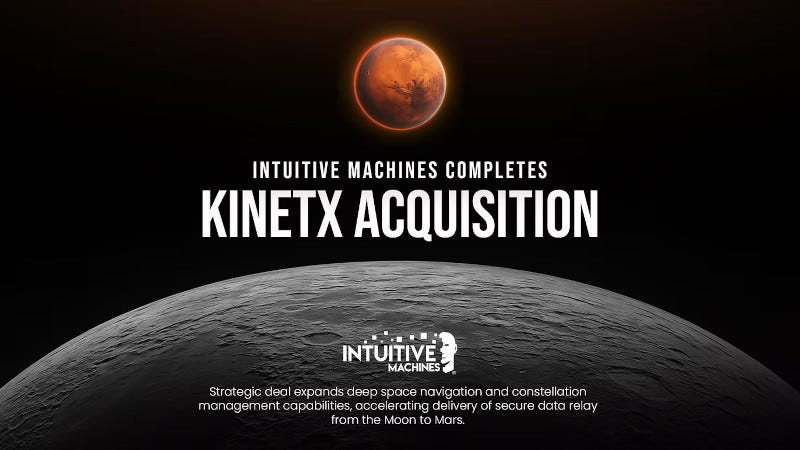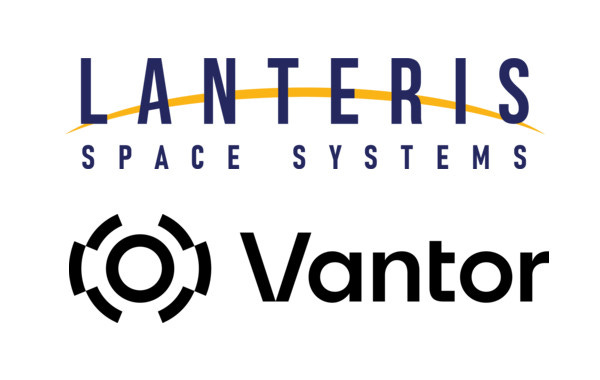We saw a couple of strategic acquisitions in the Space Commerce world this week.
Intuitive Machines has completed its previously announced acquisition of KinetX, which specializes in deep space navigation, systems engineering, and constellation mission design. Intuitive Machines says the acquisition enhances its ability to provide customers secure, reliable communications and precision navigation for lunar and interplanetary missions, by combining its data service platform with KinetX deep space navigation technology.
The stock acquisition was completed for $30 million before closing adjustments, including approximately $15 million in cash and approximately 1,400,000 shares of Intuitive Machines common stock. With a track record supporting NASA and other leading space agencies, KinetX is certified by NASA for deep space navigation and has supported some of the most ambitious planetary missions in history, including navigation services to Mercury, Pluto, asteroids, and the Moon.
The acquisition extends Intuitive Machines’ infrastructure footprint across Houston, Phoenix, Maryland, and other U.S. locations, aligning with key opportunities in civil exploration, national security space, and future Mars telecommunications programs.
-0-
Optical communications are essential for proliferated low-Earth orbit architectures, resilient space networks and real-time decision advantages. To enhance its next-gen communications solutions, Voyager Technologies has completed the acquisition of BridgeComm Technologies.
Voyager says the strategic acquisition accelerates the company’s ability to deliver advanced optical communication solutions for the defense and commercial markets, fast-tracking internal development efforts. The company can now develop differentiated systems on a much shorter schedule, enabling the company to address the growing requirements for secure, high-throughput low-latency connectivity. The technology also supports commercial applications, including linking aircraft to commercial satellite constellations for higher data throughput across global networks.
The acquisition builds on Voyager’s capabilities in advanced sensors, AI-enabled edge processing and on-orbit infrastructure, reinforcing the company’s ability to deliver mission-ready solutions across domains.
-0-
Two divisions of Maxar have new names and tools to tackle rising demands in security and data analysis. Maxar Space Systems is now Lanteris Space Systems, while Maxar Intelligence has become Vantor.
Lanteris Space Systems, headquartered in Palo Alto, California, brings together 1,500 workers to build satellites and systems for missile tracking, secure links and trips to the moon and Mars.
In Westminster, Colorado, Vantor rolled out Tensorglobe, a software setup that blends feeds from orbit, air and ground to create a live 3D map of Earth. It helps spot risks and guide drones without GPS signals. The firm put up six advanced imaging satellites between May 2024 and February 2025, and its tools back U.S. programs like the Geospatial Enterprise Ground Data and One World Terrain for training and planning.
Vantor has teamed up with Anduril Industries on Army gear, plus Saab and Taiwan’s Aerospace Industrial Development Corp. to fit its software into frontline setups.
-0-
Coming up, a 10-launch deal for Rocket Lab. But right now, why not take a minute to become a paid subscriber to The Journal of Space Commerce. Whether you’re a space professional, investor or an enthusiast, paid subscribers have first access to premium articles and podcasts focused on the new space economy. Just visit www.exterrajsc.com on Substack, and help keep The Journal of Space Commerce independent as we chronicle, cajole and, when necessary, critique the commercial space industry.
-0-
A new contract for a further 10 dedicated Electron launches for SAR satellite company Synspective has been announced by Rocket Lab. The deal brings the total number of upcoming Synspective missions to 16, marking the largest order of dedicated Electron missions with a single customer to date.
Following the first launch agreement inked in June 2024, this second multi-launch contract within 18 months secures the launch of a total of 21 additional StriX SAR satellites across multiple missions through to the end of the decade.
Rocket Lab has been Synspective’s sole launch provider to-date. The first six StriX satellites were deployed across six dedicated launches from Rocket Lab Launch Complex 1 in New Zealand. The next 10 dedicated Synspective launches will take place from the same New Zealand launch site
-0-
NASA has awarded a contract to raise a spacecraft’s orbit to Katalyst Space Technologies of Flagstaff, Arizona. Katalyst’s robotic servicing spacecraft will rendezvous with the Neil Gehrels Swift Observatory and raise it to a higher altitude, demonstrating a key capability for the future of space exploration and extending the Swift mission’s science lifetime.
NASA’s Swift launched in 2004 to explore the universe’s most powerful explosions, called gamma-ray bursts. The spacecraft’s low Earth orbit has been decaying gradually, which happens to satellites over time. However, because of recent increases in the Sun’s activity, Swift is experiencing more atmospheric drag than anticipated, speeding up its orbital decay.
NASA has awarded Katalyst $30 million to move forward with implementation under a Phase III award as an existing participant in NASA’s Small Business Innovation Research (SBIR) Program.
The orbit boost is targeted for spring 2026, though NASA will continue to monitor any changes in solar activity that may impact this target timeframe. A successful Swift boost would be the first time a commercial robotic spacecraft captures a government satellite that is uncrewed, or not originally designed to be serviced in space.
-0-
A global initiative designed to elevate scientific opportunities in microgravity research, technology development, research and development (R&D), and commercial innovation in low-Earth orbit (LEO) has been launched by Axiom Space. With 15 current partners across the U.S., Europe, and Australia, the Axiom Space University Alliance is expanding rapidly to become the world’s leading network of academic institutions focused on advancing space science during the transition from government-led to commercially-owned and operated space stations.
The Axiom Space University Alliance invites academic institutions and scientific research organizations around the world to collaborate under a shared vision: to ensure that access to microgravity for research, innovation, and exploration remains a priority across the world as governments and global stakeholders navigate a transition to a commercial space ecosystem. The Alliance acts as a global voice advocating for microgravity research and technology development as well as R&D toward commercial opportunities. It will also help identify research gaps and opportunities that can shape national and international research priorities. It aligns the global research community around common challenges and opportunities, providing a forum for international cooperation and resource sharing.
With the Axiom Space University Alliance now officially launched, the company is welcoming universities, industry leaders, and government agencies to learn more about this global effort. Through the Alliance, Axiom will work to ensure that space science continues to thrive, that innovation is inclusive and collaborative, and that the transition to commercial space is guided by a strong, united research community.
-0-
In Depth this week, with a partial government shutdown making headlines, we looked at President Trump’s proposal to slash funding for the Office of Space commerce, and the potential for the elimination of the TraCSS program.
Trump has long seemed to be a proponent of space programs and the space industry, reestablishing the National Space Council during his first term, and spinning the U.S. Space Force out of the U.S. Air Force, establishing it as a stand-alone branch of the Department of War. But now, there appears to be a schism when it comes to space, and particularly commercial space, in the current Trump administration.
The Office of Space Commerce (OSC), housed within the National Oceanic and Atmospheric Administration, has found itself in the crosshairs of what appears to be a systematic dismantling effort. The Trump administration’s fiscal 2026 budget proposal seeks to slash the office’s funding from $65 million to just $10 million—an 84% reduction that would effectively terminate TraCCS operations.
But in Trump’s Executive Order “Enabling Competition in the Commercial Space Industry”, the President mandates that the Office of Space Commerce be elevated to the Secretarial level, reporting directly to the Secretary of Transportation.
The industry is very adamant that the TraCSS program be preserved. A coalition representing more than 450 companies across seven major trade organizations has launched a coordinated lobbying campaign to maintain the program.
Space traffic management directly impacts the commercial space multi-billion dollar economic powerhouse. Satellite operators spend approximately $4.2 million annually on collision avoidance operations per 1,000 satellites. Insurance costs provide another window into the financial stakes. The worldwide satellite insurance market generates approximately $800 million in premiums annually, with third-party collision coverage adding another $20 million.
Many in Congress are also opposed to the cuts to OSC and TraCSS.
The pattern of the Trump administration’s decision-making suggests the TraCCS controversy may be part of a broader negotiating strategy rather than a final policy position. The administration has consistently used dramatic proposals as opening positions in budget and policy negotiations, often moderating its stance in response to stakeholder pressure.
So what began as a signature achievement of Trump’s first-term space policy has become a test case for his second-term governing approach. The outcome will signal whether the administration’s commitment to American space leadership extends to the unglamorous but essential work of managing orbital traffic, or whether cost-cutting imperatives will win the day. When you take into account the partial government shutdown, the midterm elections looming, the 2028 Presidential election visible on the horizon and candidates chasing campaign funding, the answer is ... as you might expect when politics is involved ... it’s complicated.
Paid subscribers can read the full analysis on The Journal of Space Commerce under the “In Depth” tab. While you’re there, check out company spotlights on Lockheed Martin and Infinite Orbits, as well as an Investor Spotlight on Yaletown Partners, and deep dives into what is driving the consolidation wave in the satellite industry and the market for U.S. Spaceports.
-0-
And those are some of the top stories we covered for you on The Journal of Space Commerce this week. Space Commerce Week is a production of Ex Terra Media. You can get daily updates on space commerce by subscribing to The Journal of Space Commerce on Substack at www.exterrajsc.com. And please consider becoming a paid subscriber. Whether you’re a space professional or enthusiast, paid subscribers have first access to premium articles and podcasts focused on the new space economy. Just visit www.exterrajsc.com and help keep The Journal of Space Commerce independent as we chronicle, cajole and, when necessary, critique the commercial space industry.
You Might Have Missed:


















